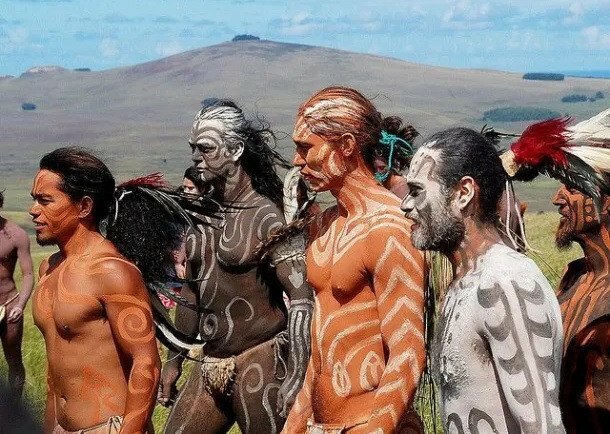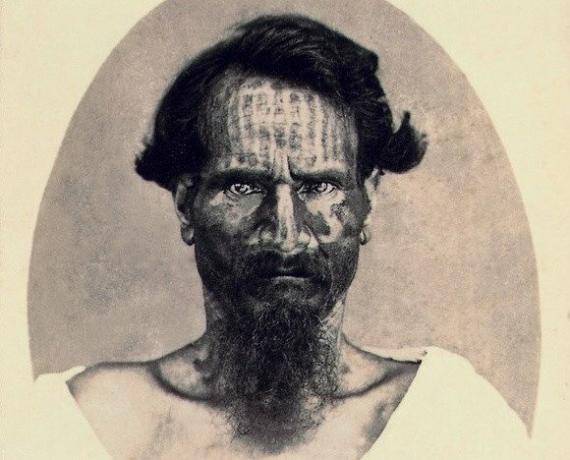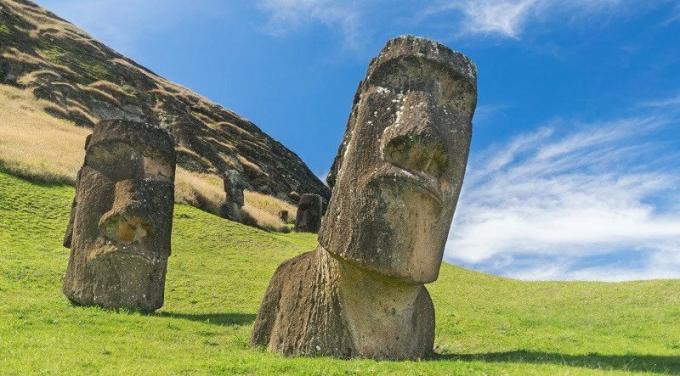The Rapanui: origins and characteristics of this civilization
The Rapanui people make up one of the most interesting ethnic groups in Polynesia; As inhabitants of Easter Island, their history has been linked to social dynamics straddling Oceania and America.
In this article we will delve into who the Rapanui are and what are its most relevant cultural characteristics.
Who are the Rapanui?
On Easter Day in 1722, the Dutch explorer Jakob Roggeveen (1659-1729) was walking on the beaches of an enigmatic island located in the middle of the Pacific Ocean, 3,500 kilometers from the American coasts and 2,000 kilometers from the nearest land inhabited. That is, a paradise isolated from the rest of the world. The navigator believed he had found the mythical Island of Davis, described by the English corsair Edward Davis at the end of the 17th century.
But no, it wasn't Davis Island. Nor was it the legendary Terra Australis, the lost continent that appeared on some maps of the fifteenth and sixteenth centuries, and that Roggeveen also longed to find. So where had the explorer arrived, that morning of April 5, 1722?
The newcomers baptized that little piece of land abandoned in the sea as Easter Island, in reference to the day they had arrived on its shores.. Later, in 1770, Spanish expeditionaries arrived at the same site; Ignoring that, fifty years before, the Dutch had already set foot on that land, they baptized the island as Isla de San Carlos, in honor of the Spanish monarch Carlos III. In addition, in a pompous celebration during which three crosses were nailed, they "annexed" the territory to the crown of Spain.
Currently, Easter Island or San Carlos Island belongs to Chile, and is known worldwide for contain the mysterious moais, the impressive volcanic stone sculptures that populate the island. What was the culture that shaped these wonders?

The origins of the Rapanui
This is how the ethnic group that currently lives on the island is known. However, it seems that the word is not native to this town: according to some historians, the denomination Rapa Nui would come from the Tahitian navigators which, in the 19th century, approached Easter Island.
The island of Rapa, located in French Polynesia, is known to Tahitians as rapa iti, that is, "Little Rapa". Thus, these navigators baptized the island of the moais as Rapa Nui, that is, "Big Rapa".
The natives know their island as I whistle or you Henua, that is, "the navel of the world". It is likely that the phrase refers to the tremendous isolation in which Easter Island is (or was) before the arrival of Westerners. The natives also describe it as kill ki you rangi, "Eyes that look at the sky", alluding to the look of his moais.

But where and when did the Rapanui come from? There are multiple theories about it. If we stick to the legend, the first king or ariki of the ethnic group, Hotu Matu'a, guided his people from the island of Hiva, which many identify with the aforementioned Rapa Iti. That is according to the Rapanui mythology itself, his people would come from the inhabitants of Polynesia, a fact that has been scientifically proven. It seems that Hotu Matu'a lived around the year 1200 AD. c. and that, recently arrived on Easter Island, he divided the people into tribes, all under his command and influence.
Good; Legends aside, historians believe that the first settlers arrived on the island around the 5th century, although this data has not been sufficiently verified. It seems, indeed, too early a date; however, the presence of some moais dating from the 5th and 6th centuries can corroborate this theory. What is historically confirmed is the presence of a human population on the island from the 18th century onwards. XIII, when, precisely, these gigantic statues begin to proliferate, of which we will speak later. continuation.
- Related article: "The 4 main branches of Anthropology: what they are like and what they investigate"
The moais: statues of the deceased?
First, we must specify what we mean. The moai are huge volcanic stone sculptures that are scattered throughout the island. and that they were built by the Rapanui ethnic group. Some 900 have been catalogued, 400 of which are found on the slopes of the Rano volcano. Raraku, the most important on the island and where the quarry where the sculptures.
The volcanic stone allows greater malleability, since it is a porous and relatively light rock. The moais were carved directly on the volcano's stone (the tuff), and were later moved to their current locations. We will talk about how this displacement was carried out in another section, although there are many theories and none are definitive.

Most of the moais are found on the huh, stone platforms that serve as support, and look towards the interior of the island, which reinforces the theory that they are elements created for the protection of the tribe. Only 8 moai direct their gaze to the sea, and one of them points with its eyes to the winter solstice.
What do these mysterious and gigantic sculptures symbolize? The original native name of these effigies, Moai Aringa OraIt sheds some light on the mystery. The expression would come to mean "living face of our ancestors", which points to a possible representation of the deceased ancestors so that they protect the town and their crops.
The fact that in some of the wars between clans some of the moais have been destroyed reinforces the theory, since, by mutilating the effigy, the protection was also "mutilated". Specifically, one of the most damaged parts are the eyes, made with white coral and volcanic stone, that they were torn from some of the moais, perhaps to avoid the vigilance and help of the ancestors.
However, since nothing has been written down nor do we have oral literature on the matter, we can only make conjectures. According to other hypotheses, the moai would be indicators of drinking water sources, so scarce on the island and so important for survival. In fact, it has been proven that where there is no drinking water, there are no moais.
A final theory, supported by a recent study led by the archaeologist Anna van Tilburg, maintains that the moais would be fertility enhancers. The fact that two moais have been found buried on the slope of the Rano Raraku volcano suggests that they were intentionally left there to preserve the crops. Van Tilburg supports his hypothesis that the slopes of the volcano are highly rich in nutrients; in fact, evidence of plantain and sweet potato cultivation has been found in the area. Thus, according to this expert, the moais that remained in their quarry of origin would have been expressly buried in a highly fertile place to guarantee the harvest.
- You may be interested in: "The most important customs and traditions of Chile"
The only one moai feminine
All the moais represented are, invariably, men, which can give us an idea of the patriarchal structure of the tribes that inhabited the island in the golden age of sculptures (centuries XIII-XIX). However, in one part of the island, the Rapanui culture had a surprise in store for the team of ethnographer Thor Heyerdahl (1914-2002) who, in 1955, made an interesting discovery.
Perched on the side of the hill was a sculpture. This was nothing in particular; We have already said that the moais are scattered throughout the island. But the effigy in question did not present the typical characteristics of the moai: it appeared full-length (instead of presenting only the bust), she was sitting on her legs, on her knees, and had her hands on her thighs instead of resting on her belly like the others. moais.
This position, together with the face raised to the sky, gave this mysterious moai an absolutely unusual attitude of prayer. But the most mysterious thing of all was that her figure seemed feminine (some breasts were hinted at on her thorax, although not at all clear). If true, we would be facing the only moai representation of a woman.
The Tukuturi moai, as it is called, has been dated several times; some experts maintain that it is one of the first manifestations of this type of sculpture on the island, which would explain its formal differences with the rest of the moais. Other theories, however, point to the opposite: that the enigmatic Tukuturi woman was made in the 19th century, precisely by the Tahitian visitors who baptized the island as Rapa Nui. The theory would be supported by the resemblance of the Tukuturi moai with the tiki, the typical totems of Polynesia.
The great mystery: how did the moais move?
Beyond their ultimate meaning, there is yet another enigma: how they were located in their current location. Despite being a rather small island (less than 25 km long), the difficulty of transporting these sculptures (with an average height of 4.5 meters and an average weight of 5 tons) is evident. Some moais are found more than 15 kilometers from the Rano Raraku volcano-quarry; how could the Rapanui displace them?
Some theories point to a transport based on sledges built with tree trunks. Later, when they arrived at the indicated site, the moais were raised by means of ropes, which made them sway and finally locate themselves in the holes, where they remained rooted.
To confirm the different theories, projects that imitate Rapanui technology have been launched over the years. One of them, carried out in 2011 by a team from the National Geographic Society, demonstrated that a 5-tonne moai could be moved with just 18 people armed with various ropes. On the other hand, in 1986, the aforementioned Thor Heyerdahl carried out a similar experiment; Together with engineer Pavel Pavel (1957) and 17 other people, they moved a 9-ton moai.
Therefore, in light of the different experiments, we can conclude that, to drag a moai, only "practice" and minimal technology are required. However, it is not the same to move one of these figures several meters (which is what these scientists achieved) than to relocate them several kilometers away, as the Rapanui did.
Anyway; this enigmatic civilization continues to remain in the shadows in many respects. Why did a handful of men and women set out to sea from Polynesia and sail, in shaky boats, 2,000 kilometers to nowhere? How did they know they were going to find an island in the middle of the Pacific? What do the mysterious moai mean? The unknowns remain open.

